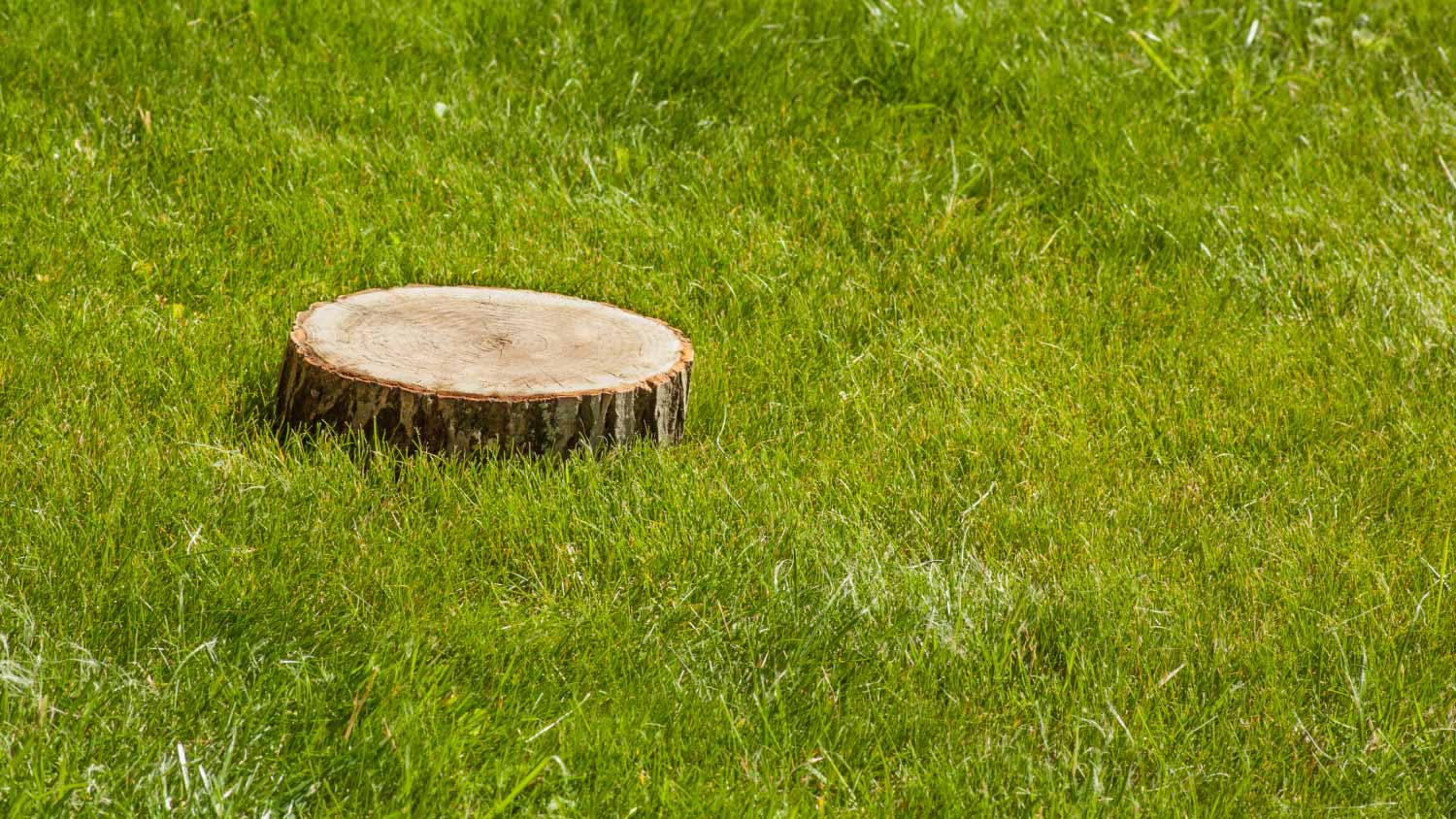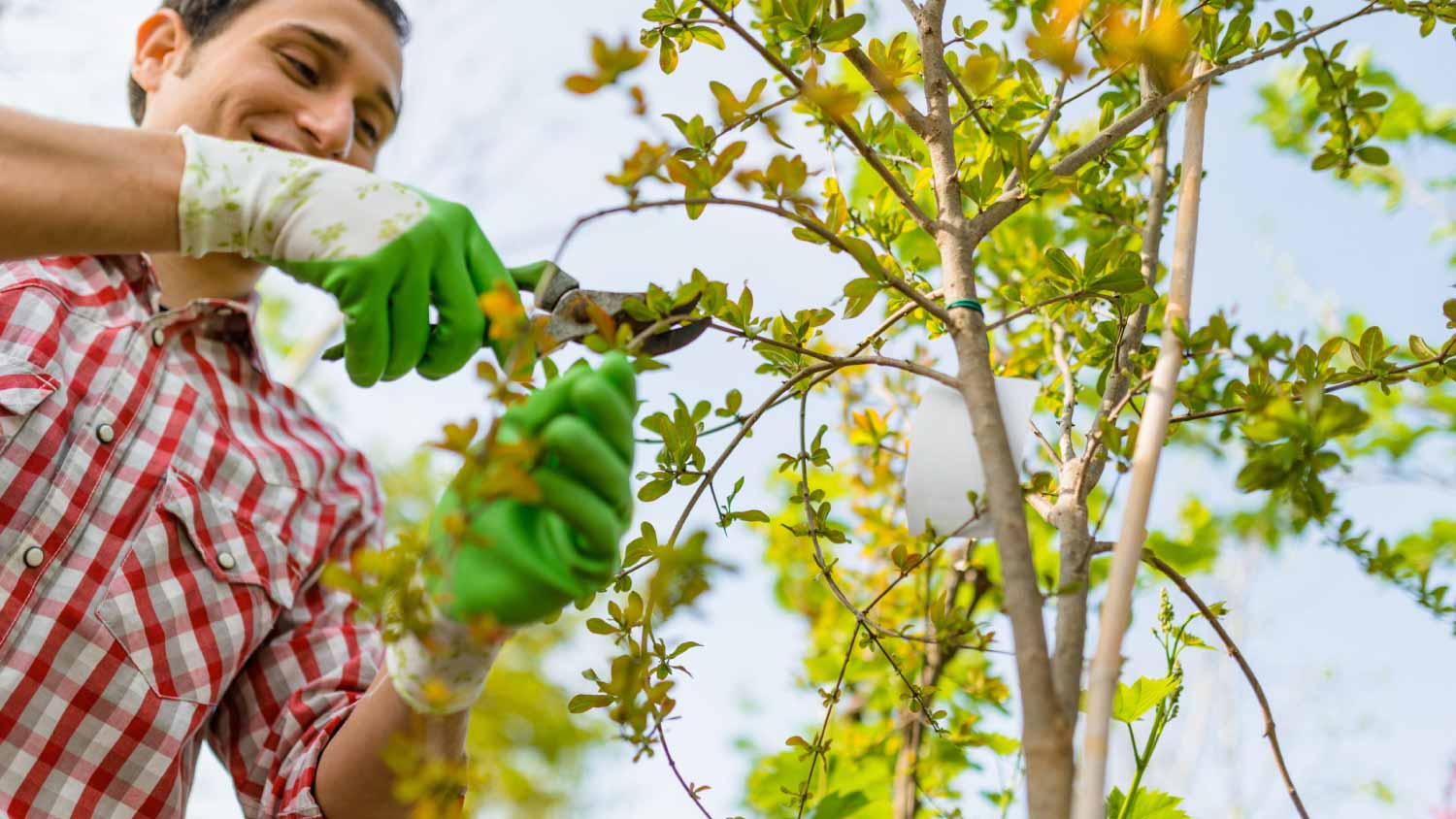
Trimming your bushes is one of the less costly aspects of landscaping, and it’s helpful to bundle many trimming services together to save money.
A tree trimming may be just what the arborist ordered for your palm, but be careful


This task has serious personal and home safety risks. You should strongly consider hiring a stump grinding professional to ensure it's completed safely and effectively.
Palm trees are a popular landscape addition for people living in warm or coastal climates, making it essential to learn how to trim a palm tree. These trees provide shade and make you feel like you’re on summer vacation all year long. While palm trees are quite low maintenance and don’t usually require consistent upkeep, they need the occasional trimming to keep them hazard-free and healthy. Here’s how to trim a palm tree to help it look its best.

With the right tools, equipment, and know-how, trimming a palm tree is a relatively straightforward process. Follow these preparation steps for success.
Now that you and your tools are prepared for palm tree trimming, follow these steps to give it a successful trim.
First, pick a time to trim your palm tree and create a plan for how much you’ll trim. Don’t haphazardly choose palm fronds to remove: Pruning palm trees solely for appearance could cause significant damage.
Conduct your trimming session during spring when the palm tree is ahead of its growing season, giving it plenty of time to recover. Prune dead, broken or obviously diseased fronds. If the palm has produced flowers, seeds, or fruit, you can remove those. You may also want to cut fronds that create safety or fire hazards. If it looks like fronds are yellowing or dying out, it’s time to check your palm’s water needs and consider getting a tree inspection to determine whether it’s diseased.
Cleaning your tools before and after each pruning session helps minimize the risk of spreading diseases from one plant to another. Use diluted bleach, alcohol or a commercial disinfectant and a cloth to thoroughly clean and disinfect your tools before you start cutting away dead, dying, or infected fronds. Never mix any cleaners together.
Make sure to only use such heavy equipment if you’re able to do so skillfully and safely. Otherwise, it’s best to hire a professional to avoid harming yourself and the tree.
Safety is a priority when trimming your palm tree. Since you’ll be using sharp tools, make sure to wear safety gloves to protect your hands. You should also wear safety goggles to prevent small pieces of palm from getting into your eyes. Take every precaution possible to ensure your safety.
There are a few different ways you can reach the fronds toward the top of the tree. For trees shorter than 15 feet, you can use a step ladder, a standard ladder, or an extension ladder. Make sure the ladder rests on steady ground, and ask a family member, friend, or neighbor to help you climb up and down and to steady the ladder while you are using it.
For taller trees, extended pole saws or cherry pickers can help you reach toward the top. While some palm tree professionals may use climbing gear like ropes and carabiners, this method is best left to certified experts. Not only is climbing a palm tree dangerous for you, but wearing spiked cleats for stability can damage the palm tree.
Look for brown or broken fronds, but don’t trim away yellowing fronds, green fronds, or any fronds from the crown of the tree. You can use a serrated knife, pruning shears, or a saw to remove fronds, but be sure to leave a space of about two inches between the palm tree's trunk and where you cut on the frond. If you cut the fronds too short, you can stress the tree or damage the trunk.
Once you’ve cut the fronds, you can pull gently on the petioles, or sharp brown blades, near the fronds. Only pull them out completely if they come out easily when you tug.
After you’ve cleared away the visible flowers, fruit, and dead fronds, you may notice more fruit stalks or previously hidden flowers. Go ahead and remove those by hand or with cleaned cutting tools.
Some palm trees may flower or develop fruit, but these objects redirect nutrients from the main plant. You can use your hands to remove the flowers and use a serrated knife or pruning shears to cut away fruit and fruit stalks. Make sure to remove flowers and fruit stalks or fruit as soon as you notice them developing for advanced palm tree care.
Palm tree waste isn’t just an unsightly mess in the lawn; it may attract pests. Make sure to pick up the fronds, fruits, and flowers and dispose of them in an organic waste bin. Tuck away any pointy petioles and other sharp elements so they don’t hurt waste management service employees.
If you aren’t sure how to safely dispose of palm fronds, especially palm fronds or fruits with pests or diseases, you can contact your local waste management service for advice.
Aside from their beauty, palm trees have a major benefit—they are low-maintenance plants. You’ll need to prune and fertilize about once a year, and watering is only required when the soil around the tree goes dry. Other than that, these trees aren’t very fussy. Follow these best practices to keep your palm trees looking great.
Prune as needed: Pruning away any dead or diseased leaves, fruits, and flowers once or twice a year can help lengthen the life of your palm tree.
Fertilize the tree: You can apply palm-friendly fertilizers about once a year to properly nourish your palm tree.
Water dry soil: Water your palm as needed when you detect dry soil. Doing so will keep your palm hydrated and healthy.

You don’t always need to trim palm trees. Unlike other plants that you may trim for cosmetic reasons, palm trees are trimmed just to minimize safety hazards. The fronds can become fire hazards, especially when the trees are close to homes and garages. They can also fall and become road obstacles or may damage nearby structures in high winds.
Pruning palms is also a helpful way to prevent palm tree diseases that attack their vitality. Dead or dying fronds, flowers, and fruits on palm trees can take away nutrients from the main plant, leading to disease.
If you have the equipment, trimming a palm tree is a low-cost DIY project. The equipment costs range from $50 to $200 if you’re purchasing multiple new pruning tools, and you can continue to use them for several years.
You should consider hiring professional palm tree trimmers near you if the tree fronds are not easily reached by a ladder. Some palm species can grow up to 70 feet high, and anything beyond 20 to 30 feet tall is best suited for pros who can safely scale a palm tree without damaging it.
Depending on the tree height, palm tree trimming costs between $125 to $800. Some pros offer discounts on trimming multiple palm trees in one session, and you can save more money by handling the cleanup yourself.
From average costs to expert advice, get all the answers you need to get your job done.

Trimming your bushes is one of the less costly aspects of landscaping, and it’s helpful to bundle many trimming services together to save money.

The cost of tree stump removal depends on size, removal method, location, and more. Our guide will show you how much stump removal costs.
Get transparent shrub removal cost info. Learn average prices, key cost factors, and tips to save on your next shrub removal project.

Before a tree stump can become rustic decor in your landscape, it’s crucial to protect it from rot, pests, and decay. Learn how to preserve a tree stump.

How long can a dead tree remain standing? It depends on a number of factors. Here’s what you need to know about removing a tree.

Wondering how to tell if a tree is overwatered or underwatered? This guide covers the signs to look out for and how to intervene.